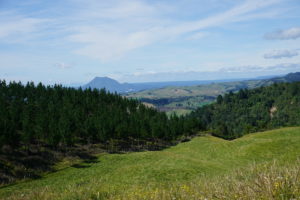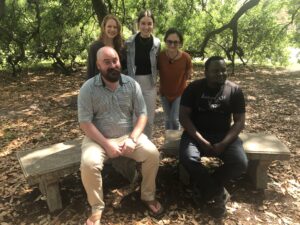BARNZ 2017-2019
Aber, S., C.J. Ebinger, A. C. Gase, C. Kalugana, F. Illsley-Kemp, I. Hamling, M. Savage, J. Eccles, S. Sabir*, J. Ristau, S. Hreinsdottir, J. James-Le* (2025), Cascading earthquake swarms in the northern Taupo volcanic zone, New Zealand, G-Cubed.
Joseph, D.Y., M. K. Savage, A. D. Jolly, C. J. Ebinger (2024), Time-varying crustal anisotropy at Whakaari/White Island Volcano, Geophys. Res. Letts., https://doi.org/10.1029/2023GL106473
2021 Environmental Science major Sophie Aber is completing a collaborative publication detailing multiple swarms of earthquakes that occurred in the northern Taupo Volcanic Zone in 2019, and their interpretation as a sector-wide magma intrusion event. The data acquisition and analyses have been assisted by Carrie Leibensberger and Betina Brockamp (Tulane undergrads), Jeysi Guillen (New Orleans Sci High student), Derrick Murekezi (Rochester undergrad), Victoria University Wellington Geophysics students Reece Franks, Sam Treweek, Megan Kortink, and now Dr Hubert Zal, Dr Finn Illsley-Kemp, Dr Martha Savage; Auckland University PhD student Franz Lutz, Pablo Aguilera, Dr Robert Pickle, Dr Jennifer Eccles, and University of Rochester Professor Alice Quillen.
The Taupo Volcanic Zone (TVZ) has the world’s highest silicic magma production rates known, and it is a fundamental component of the Hikurangi subduction system. The northern TVZ transitions to backarc spreading in the Whakatane rift zone offshore. Yet, many questions remain regarding the spatial distribution of magma bodies, the proportion of extensional strain accommodated by normal faulting and magma intrusion, and the nature of the transition to seafloor spreading in the Whakatane back-arc rift zone. In October 2017, we deployed 7 broadband seismometers in the northern TVZ, enclosing the zone of long-lived uplift and seismic swarms along the western flank of the Whakatane graben. We use the BARNZ array and existing GEONET stations to locate earthquakes and determine focal mechanism solutions in the northern TVZ and Whakatane basin. We report on the first 8 months of seismicity, including the October 31, 2017 Mw 4.7 earthquake and aftershocks. First motion focal mechanisms indicate the mainshock was oblique normal slip, and aftershocks occurred along an approximately 15 km-long segment of the White Island border fault. New crustal-scale seismic imaging from the SHIRE experiment, and existing reflection data provide constraints on the time-averaged deformation for comparison with our active deformation studies
.


Sophie Aber is center back, along with her teammates Kevin Reece, Martin Musila, Samantha Hilburn, Carolina Hurtado-Pulido and James Lopez (absent) in the National Renewable Energy Geothermal competition, 2022, where they won the Geothermal Award for South and Appalachian region.
